
The silver spinyfin is a spinyfin of the genus Diretmus, found around the world except the Mediterranean, at depths down to 2,000 m. It belongs to the monotypic genus Diretmus. Their length is between 30 and 40 cm.

The hāpuku, hapuka or whapuku, also known as groper, is a wreckfish of the family Polyprionidae, found around southern Australia, southern South America, South Africa, Tristan da Cunha and New Zealand at depths between 30 and 800 m. Its length is between 60 and 180 cm, and it can weigh up to 100 kg. It is sometimes described locally as cod, although that properly refers to other fish.

The clown toado a pufferfish of the genus Canthigaster, is found in the southwest Pacific Ocean including Australia, the northeast coast of New Zealand, and New Caledonia. Its length is between 10 and 20 cm.
The black ruff is a medusafish, the only member of the genus Centrolophus. It is a pelagic fish found in all tropical and temperate oceans at depths of 0 to 1,000 m. Its length is typically up to 60 cm (24 in), but it may reach 150 cm (60 in). Other common names include rudderfish and blackfish.
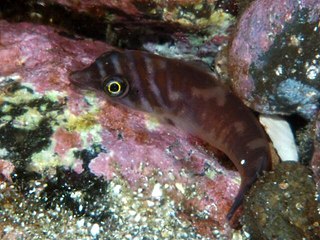
Clingfishes are fishes of the family Gobiesocidae, the only family in the order Gobiesociformes. These fairly small to very small fishes are widespread in tropical and temperate regions, mostly near the coast, but a few species in deeper seas or fresh water. Most species shelter in shallow reefs or seagrass beds, clinging to rocks, algae and seagrass leaves with their sucking disc, a structure on their chest.

The abyssal grenadier, Coryphaenoides armatus, is an abyssal fish of the genus Coryphaenoides, found in all the world's oceans, at depths between 800 and 4,000 metres. Its adult length is 20 to 40 centimetres, although Fishbase gives lengths up to 1 metre. The abyssal grenadier's body is unique in that it contains two dorsal spines and about 124 dorsal soft rays, which are the flexible jointed rays supporting a fin nearest to the back in the spinal column. It has no anal spines, but has 115 anal soft rays along its body. The head and eyes of this fish are very large, while the mouth is very small. The color of the abyssal grenadier is brown apart from the abdomen, which is bluish.

The southern conger is a conger of the family Congridae, found in the eastern Indian Ocean and south-western Pacific Ocean, including southern Australia and New Zealand, at depths down to 100 m in broken rocky reef areas. Length is up to 2 m and weight may be up to 5 kg.
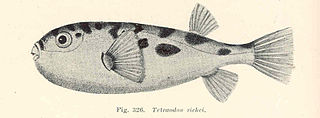
The prickly toadfish is a pufferfish of the family Tetraodontidae, found in the eastern Indian Ocean and the southwest Pacific Ocean, at depths down to 50 m. Its length is up to 25 cm.

The starry toado is a pufferfish of the family Tetraodontidae, found in subtropical oceans worldwide, at depths between 10 and 360 m. Its length is up to 40 cm.
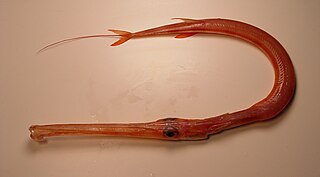
The red cornetfish, also known as the rough flutemouth, is a cornetfish of the family Fistulariidae, found in subtropical and tropical oceans worldwide, at depths between 10 m (33 ft) and 200 metres (660 ft). They are up to 2 m (6.6 ft) in length but rarely exceed 1 m (3.3 ft).

Lagocephalus lagocephalus oceanicus, is a pufferfish of the family Tetraodontidae, found in the western Pacific Ocean in temperate and tropical waters. Its length is up to 45 cm. The dorsal and anal fins falcate, the caudal fin is lunate. The lower one third of the pectoral fin is white. It is thought to be responsible for fatal poisoning, therefore it should not be eaten.

The Portuguese dogfish or Portuguese shark, is a species of sleeper shark of the family Somniosidae. This globally distributed species has been reported down to a depth of 3,675 m (12,057 ft), making it the deepest-living shark known. It inhabits lower continental slopes and abyssal plains, usually staying near the bottom. Stocky and dark brown in color, the Portuguese dogfish can be distinguished from similar-looking species by the small spines in front of its dorsal fins. Its dermal denticles are also unusual, resembling the scales of a bony fish. This species typically reaches 0.9–1 m (3.0–3.3 ft) in length; sharks in the Mediterranean Sea are much smaller and have distinct depth and food preferences.

The devil fish or giant devil ray is a species of ray in the family Mobulidae. It is currently listed as endangered, mostly due to bycatch mortality in unrelated fisheries.

The starry smooth-hound is a houndshark of the family Triakidae. It is found on the continental shelves of the northeast Atlantic, between latitudes 61 and 16° N, from the surface to a depth of 200 m (660 ft).
Sicyopterus lagocephalus, the red-tailed goby or blue stream goby, is a species of goby native to islands of the Indian Ocean from the Comoros to the Mascarene Islands to the Pacific Ocean where it reaches French Polynesia and can be found as far north as Japan. It is an amphidromous species: adults can be found in swift-flowing streams with rocky beds but the eggs hatch at sea and the larval stage remains in marine waters, migrating to freshwaters when they reach the postlarval stage. This species can reach a total length of 13 cm (5 in). In some places it is an important species for local consumption with the post-larvae being caught as they mass in estuaries.
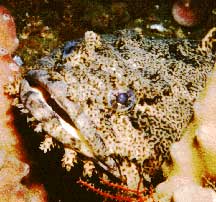
Toadfish is the common name for a variety of species from several different families of fish, usually because of their toad-like appearance. Dogfish is a name for certain species along the gulf coast.
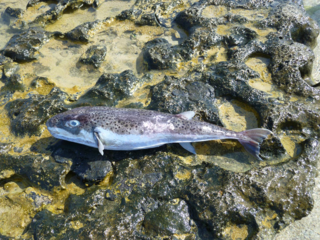
Lagocephalus spadiceus, also known as the half-smooth golden pufferfish, is a species of fish in the family Tetraodontidae. It is a common fish in the Red Sea, as well as the Indian Ocean, but can be found also in the Mediterranean, where it arrived from its natural habitat by Lessepsian migration.

Lagocephalus sceleratus, commonly known as the silver-cheeked toadfish, or Sennin-fugu, is an extremely poisonous marine bony fish in the family Tetraodontidae.
The diamondback puffer is a species of pufferfish in the genus Lagocephalus.

















